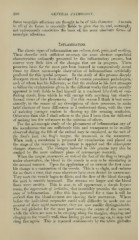Page 680 - My FlipBook
P. 680
690 GENERAL PATHOLOGY.
Some neuralo-ic aifections are thouoht to be of this character. Anaemia
m all of its forms is especially liable to give rise to, and, seemingly,
not unfrequently constitutes the basis of, the more obstinate forms of
neuralgic affections.
Inflammation.
The classic signs of inflammation are redness, heat, pain, and swelling.
These describe -with sufficient accuracy the more obvious superficial
characteristics ordinarily presented by the inflammatory process, but
convey very little idea of the changes that are in progress. These
processes have for the most part been learned in comparatively recent
times by direct microscopic observation of inflammations artificially
produced for this special purpose. In the study of this process sharply
divergent views have been developed by certain prominent pathologists, -
each of whom has his followers ; so that the student in his first attempts
to follow the explanations given in the different works that have recently
appeared is very liable to find himself in a confused labyrinth of con-
flicting detail, from which he will emerge with anything but clearly-
formed views of the phenomena. For this reason I think it best occa-
sionally, in the course of my descriptions of these processes, to make
brief citations of these differences as I understand them, with the view
of assisting younger readers in clearing up this seeming confusion.
Otherwise than this I shall adhere to the plan I have thus tar followed
of making but few references to the opinions of others.
For the microscopic study of the phenomena of inflammation any of
the membranes that are sufficiently thin and transparent to be readily
observed during the life of the animal may be employed, as the web of
the frog's foot, the frog's tongue, the omentum, or the mesentery.
When such a membrane is prepared for examination and placed on
the stage of the microscope, an irritant is applied and the subsequent
changes observed. The changes induced in this process may also be
studied by the more ordinary plans of microscopic research.
When the tongue, mesentery, or web of the foot of the frog is brought
under observation, the blood in the vessels is seen to be circulating in
the normal manner. Upon the application of an irritant the first nota-
ble change is a contraction of the vessels. This is so slight, and endures
for so short a time, that some obsei'vers have even denied its occurrence.
Very soon the vessels begin to dilate, and the flow of the blood through
the part is notably increased. The streams are larger and the blood
flows more swiftly. This is now, to all appearance, a simple hyper-
remia, the hypencniia of irritation, that invariably precedes the ap]iear-
ance of inflammation. After this has persisted for a time it will be
noticed that the blood-streams are slowing their movement. Where
before the individual corpuscles could with difliculty be made out on
account of their rapid movement, they are now readily distinguishable.
The red globules for the most part occupy the centre of the current,
while the Avhite are seen to be creeping along the margins, stopping and
clinging to the vessel's M'all, then letting go and moving on, to stop and
cling fast again. This is repeated continuously by the white globules


